Learning how to sing on key is important for any singer, especially if you are in a band or karaoke.
Being on key means that your voice is in harmony with the music supporting you (meaning that everything sounds wonderful…)
That’s why in this guide we are going to show you step by step how to sing on key whether you are a beginner or advanced singer.
So let’s get started.
______
Can You Learn How To Sing On Key?

Yes, learning how to sing on key is a skill that you can train for.
There is a slight difference between singing on key and singing on pitch.
Singing on key means you are hitting all the notes within that key (or scale) while singing on pitch means that you are hitting every note accurately, even if the note isn’t part of the key.
For example, if I’m singing a song in the key of Major C, that means if we think about a piano then I am hitting all the white keys.
However, when I sing a black note, that means I am off key.
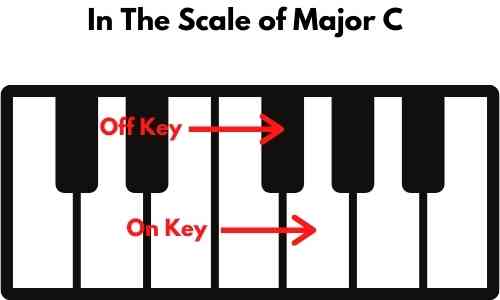
Simple, right?
Learning how to sing on key is incredibly important for a singer so that you don’t sound out of tune when you are having a live performance with your band members.
So let’s gets started on finding the right key for your voice.
______
1. Find What The Original Key Of The Song Is

The first step in learning how to sing in key is to find where the original key of the song is.
For example, let’s say that we want to find the key of “Haven’t Met You Yet” by Michael Buble.
The easiest way to find a key in any song is to Google it like below…
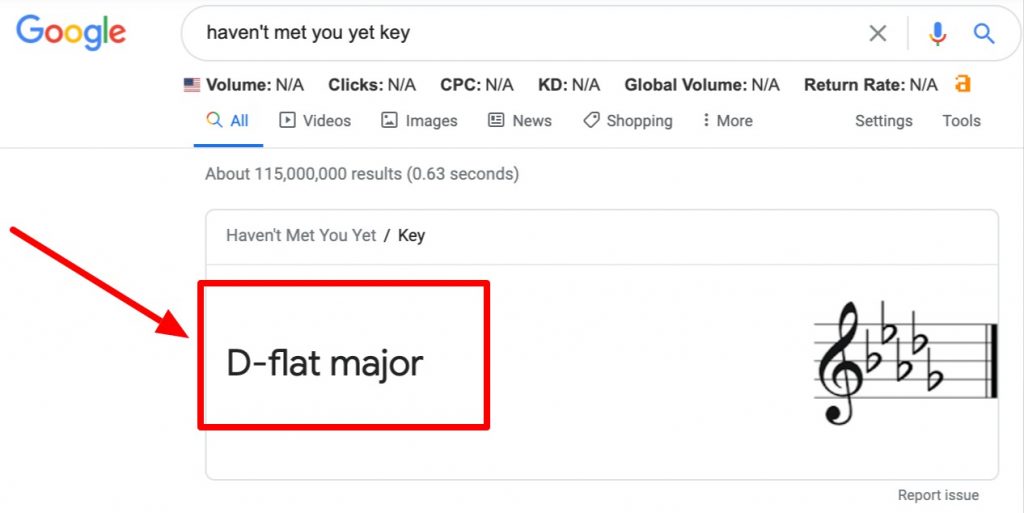
It’s really that simple.
There are also a couple of other ways to find the key:
- Go to Music Notes and check what key the person transcribed it to like below…
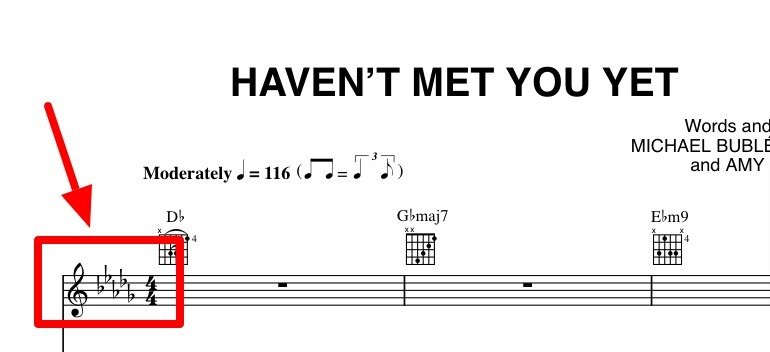
- Or listen to the song and find the Major 1 note (for advanced singers…)
So now that we know what key the song is, that means we know what notes we have to sing to make sure we are on key.
For those who don’t know the C♯ Scale, that means we have to hit the following notes:
- C♯, D♯, F, F♯, G♯, A♯, and C below…

So this means that if we sing any of the notes above, then we are on key.
And if we don’t sing those notes, then that means we are off key.
______
2. Start Changing The Key So It Fits With Your Voice

Now that you know the song you want to sing and it’s original key, the next step is to find the perfect key for your voice.
If you’re a baritone singer like me, then it’s going to be hard to sing songs that have a higher range like Bruno Mars or Sam Smith.
Here’s why we need to change the key for your voice:
- If you’re performing live gigs, then you want to sing at a comfortable range so your voice can last the whole performance…
- And your voice naturally shines at a specific range with your own unique tonality…
So here’s how I would find the key to sing in: Sing in multiple keys and see what sounds great and comfortable for your voice.
For example, let’s say I want to find the best key to sing in for “Haven’t Met You Yet” by Michael Buble.
The first thing I want to do is find the highest and lowest notes of that song in the original key.
So after doing some research, I found that the highest note is a G4 and the lowest I could find was a D3.
G4 is literally the highest note I can sing in my voice, which means I need to lower the key so that I can sing it confidently for performances.
Now, I would go to Youtube and use this chrome extension to lower two keys and see how it feels like.
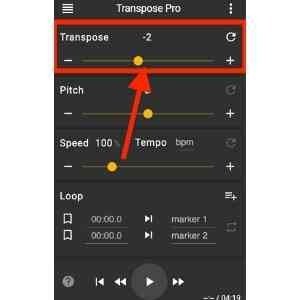
I noticed it sounds a lot better and much more natural to my voice so this new key of B major works really well for my voice.
Here are some things you want to consider when finding the best key for your voice:
- Can you project the highest note with power and accuracy?
- Can you do the same with your lowest note?
- Is this a song that you can perform within your entire performance without getting tired?
These are the essential questions you need to ask yourself before you pick the right key for your voice.
______
3. Start Learning To Sing On Pitch With This New Key

When you are learning how to sing on key, it is incredibly important that you learn how to sing on pitch for that specific key.
Otherwise, it’s just not going to sound good, even if the key you picked feels natural in your voice.
I’m just going to assume you know how to sing with proper breathing techniques for your voice so we can get started right away.
Here’s how you sing on pitch with this new key: Slow down the song to 0.25 and make sure that you are hitting each note accurately.
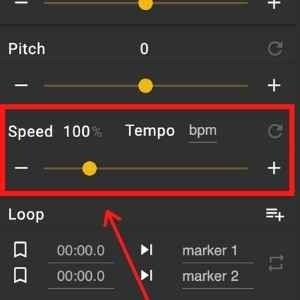
Then when you can confidently hit these notes at a slow speed, then you want to slowly increase the speed by intervals of 3-5%.
Let’s go back to the example of me trying to sing “Haven’t Met You Yet” by Michael Buble.
Here are the exact steps I would do to make sure I am singing on key:
- Find the line I want to sing on pitch (Ex. the first line “I’m not surprised.”)
- Slow down the song to 0.25 in the key I want to change in (2 keys down…)
- I will copy how he sounds and make sure I’m staying on pitch…
- I would increase it to 30% once I feel like I’m singing on pitch…
- Then over time I would sing it at original speed.
It’s a simple progression to let you know exactly what you need to work on to stay on pitch.
If you can already sing the melody while being on pitch already, you are going to notice it’s exponentially easier to find the right notes in a different key.
That’s because when we are changing a key, all we are doing is moving up all the notes up or down (So in my example we are moving all the notes down by 2.)
And by gradually speeding up the process and singing on key, you are training your muscle memory in your voice to sing without thinking about it.
Finding the right key for your voice is especially important to highlight the emotions within your song.
If you sing too high and you won’t have power to express yourself and sing too low and it won’t have the impact you want on your audience.
______
4. Practice Singing The Major Scales

Learning how to sing the major scales will help you understand how to sing on key for future songs.
This is because all major scales are part of a specific key and learning how to sing them will exponentially make it easier for you to stay on key throughout the song.
For example, if the song you’re singing in is Major C and you know the major C scale, then you know which keys you need to hit to stay on key.
That’s why learning these major scales and doing it for warmups is important because you are creating muscle memory for your voice for these major scales.
That means you don’t have to consciously think if you are singing on key because it just feels natural.
And once you learn the major scales, you should also move on to learning:
- The minor scales
- And the harmonic scales
This is because learning how to sing these different scales will make it easier for you to find the right key when you are singing a song and will make you much more accurate when you are trying to find the key of the song by ear.
Plus, learning all these scales makes your voice versatile whether you want to sing some vocal runs or sing on key with your falsetto.
Here’s a singing exercise to practice singing your scales: say the word “mum” while going up and down a scale.
And when you finish doing a 5 note scale up and down, go up a notch to your highest range and then go back down.
The reason we say the word “mum” is because it combines humming the word with an easy “uh” sound without having to strain the throat.
This is a great exercise for warmups and adding scales to your muscle memory.
______
5. How To Sing On Key With A Guitar

There are two things you want to consider when learning how to sing with the guitar:
- Your vocal range and experience
- Your guitar skills
So here are the steps in learning how to sing on key with a guitar:
- Find a key you can comfortably sing and play on the guitar (C major scale)
- Be able to sing on key with just your voice along with your favorite artist (don’t bring the guitar in yet…)
- Now play the guitar song fully without singing.
- Now try playing and singing the guitar really slowly together.
- If you sound off key, then listen to the song again and go line by line.
So here’s how I would sing in key with my example song:
For example, we found for my example song “Haven’t Met You Yet” that the best key for me to sing in is C sharp, but when I try to play that on the guitar there’s a lot of barre chords that it isn’t the easiest thing to do in the guitar.
So what I would do is I would transpose the song and drop it one more key to C major scale where the notes are a lot easier to play on the guitar.
Now that I have the key, I want to practice singing with the artist on Youtube to make sure that I am hitting the notes accurately.
Then what I would do is try to play the song with my guitar without singing.
The reason we do this is to isolate any variables to make sure that we can sing and play the guitar by themselves before we combine it.
Now, what I would do is I would go line by line and sing and play the guitar slowly to make sure that each note I hit is on key.
If I don’t sound like I’m on key, then I would do:
- Listen to a line and sing along with Michael Buble (ex. The first line “I’m not surprised…”)
- Then sing that melody while you pause that song. (Acappella)
Once you can do that, then you want to try again with that same melody while playing the guitar.
It takes practice and coordination, but over time it will be easier to find the key and stay on key.
And through multiple practice sessions, you can later learn how to add vibrato and vocal runs to your singing as well.
______
How To Choose The Right Key For Your Voice
What Is The Song Genre?
One thing that you want to consider when singing in key is to determine what your song genre is.
Depending on your genre will also help you figure out whether to raise or lower the key.
Here are some examples:
- Pop: You want a higher key to show your vocal prowess on those higher notes…
- Rock: You want a key that highlights how loud your voice can get for the chorus…
- Sexy Jazz: You can get away with a lower key that’s comfortable for your voice…
Knowing what genre you sing in gives you an idea of what people are looking for when they listen to that genre.
Who Are Your Musicians?
It’s also really important to consider who your bandmates are when picking a key for the song.
Although the singer has the most priority, also take into the experience and equipment of your band members.
For example, as a musician, it’s a lot easier to play a song in the C major scale rather than a C sharp major scale.
However, there are also instruments like a digital piano that can easily transpose a key without changing the notes.
It’s these little things that can make a difference during a live performance.
How Do You Sound In That Key?
The most important thing to choose a key is how do you truly sound in that key.
- Do you think it matches your voice perfectly, or do you think that you can’t give enough power in that vocal range?
In the end, it’s choosing the right key that highlights your voice.
So choose the key that you think fits your vocal range and perform it on stage.
Conclusion
In this guide I went over the difference between singing on pitch and singing on key and a system so that you can improve both.
I showed you how to find the original key and how to change the key so that it fits your voice.
I also went to show you a little music theory with the major scales and some important questions to consider when choosing a key for a performance.
And once you become more confident in your voice, then you can slowly add a bit of falsetto and maybe some distortion to your voice as well.
Let me know in the comments below if you have any questions.







